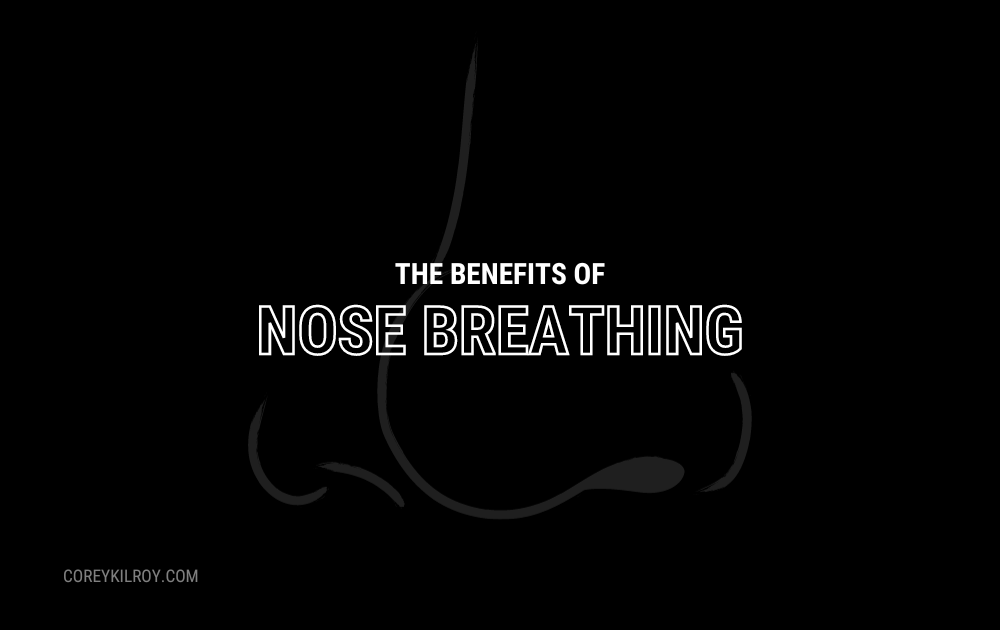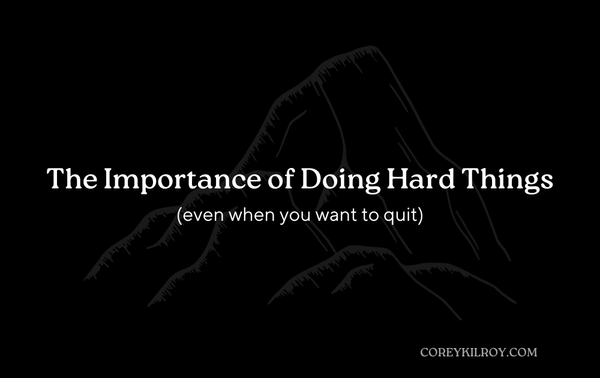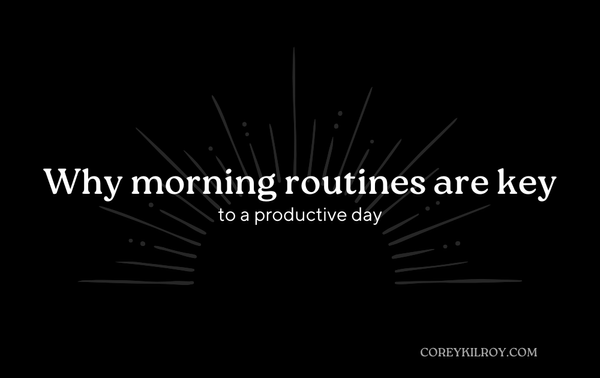Nasal Breathing vs Mouth Breathing

Why You Should Be Breathing Through Your Nose.
More often than not, you breathe without even thinking about it.
When you breathe, your body does it automatically, without much – or any – effort whatsoever.
However, it’s important to pay attention to how you breathe.
Specifically, it’s much healthier to breathe through your nose instead of your mouth.
Yet, it’s estimated that about 30-50% of adults breathe through their mouth, which could potentially lead to health issues down the line.
Let’s dive a little deeper…
Nasal Breathing vs Mouth Breathing
Before getting into the physiological differences between nasal vs mouth breathing, I wanted to talk about the effects both types have on your facial shape.
When you breathe through your nose, your tongue naturally fills your palate space and exerts upward and outward pressure. It promotes the forward growth of the jawbones.
But with mouth breathing, without this upward and outward pressure, the weight and force of the facial muscles will cause the top jaw to “fall down” or elongate. This can also lead to the appearance of a gummy smile.
This chronic mouth breathing can lead to an elongated and narrow facial shape, which doesn’t leave enough room for the teeth or tongue.
Moreover, if you develop a mouth breathing habit as a child, the bottom jaw will never grow forward fully and can lead to a retruded chin, an obtuse bottom jaw angle, crowding of the teeth, and a constriction of the space where the tongue is supposed to rest (observed in the diagram above).
These changes aren’t just an aesthetic problem.
This change in facial shape can constrict airway passages, which can affect your sleep.
If you look like this kid when you sleep, then you’re setting yourself up for poor sleep and potential health risks (more on this later).
But to preface, poor sleep and the cumulative medical effects of sleep loss pose an increased risk of hypertension, depression, and obesity.
Nasal Breathing
Your nose is designed to help you breathe safely and efficiently. It can do this due to its ability to:
- Filter out foreign particles - Nasal hair filters out dust, allergens, and pollen, which helps prevent them from entering your lungs.
- Humidify inhaled air - When you breathe in, your nose warms and moisturizes the air. This brings the air you inhale to body temperature, making it easier for your lungs to utilize.
- Produce nitric oxide - During nasal breathing, your nose releases nitric oxide (NO). NO is a vasodilator, which means it helps to widen blood vessels. This can help improve oxygen circulation in your body. (possibly giving you a nicer pump while in the gym? 👀)
Mouth Breathing
Your mouth helps you eat, drink, and talk.
You can also use your mouth to breathe, but it doesn’t have many of the unique features that your nose has for this purpose.
In some cases, mouth breathing is necessary. You might need to breathe through your mouth if you have:
- nasal congestion
- a deviated septum
- small nostrils
But in general, you should be breathing out of your mouth as little as possible, or not at all if able.
Benefits of nasal breathing
Since your nose was specifically designed to help you breathe, there are some obvious advantages to nasal breathing.
First, to recap, we learned that:
- The nose acts as an air filter, delivering clean air to the lungs and reducing the amount of allergens that get in.
- The nose humidifies the air when you inhale, making it easier on the lungs.
- Nose-breathing produces nitric oxide (NO), which helps with oxygen absorption and sterilizes the air.
Nose breathing has a plethora of other benefits as well.
It allows your nasal cavities to:
- aid your immune system by activating immunoglobulin production
- increase airflow to arteries, veins, and nerves
- increase oxygen uptake and circulation
- slow down breathing
- improve lung capacity
- strengthen the diaphragm
- lower your risk of allergies and hay fever
- reduce your risk of coughing
- lower your risk of snoring and sleep apnea
- support the correct formation of teeth and mouth
Risk Factors of Mouth Breathing
On the other hand, many people still unknowingly mouth breath throughout the day.
This can cause many health problems down the line.
In the short-term, mouth-breathing leads to issues including:
- Dry mouth: mouth-breathing dries out the mouth, removing the first defense against oral bacteria. This can lead to consequences such as chronic bad breath and tooth decay.
- Lack of energy: getting less oxygen by breathing through the mouth will result in poor sleep quality and lowered energy levels overall. For kids, this means difficulty paying attention in school. For adults, work productivity & social life can suffer.
The negative effects of mouth-breathing don’t stop in the short-term. They can actually be life-altering, particularly when the habit begins in childhood and goes unchecked.
- Facial structure: like we mentioned earlier, mouth breathing can actually lead the bones of the face to develop differently, yielding flat features, drooping eyes, a narrow jaw and dental arch, and a small chin.
- Sleep apnea: the risk of sleep apnea goes up with mouth breathing, and this can make it difficult to get a restful night’s sleep.
- Orthodontic treatment: the narrowed dental arch of a chronic mouth-breather can cause inadequate room for a full set of adult teeth, and this will require orthodontic treatment to correct.
It could also increase your risk of:
- inhaling unfiltered air
- allergic reactions to allergens
- asthma
- bad breath
- tooth decay
- gum inflammation (gingivitis)
- snoring
- sleep apnea
How to Improve Nasal Breathing?
Breathing exercises may help improve your nose breathing.
These techniques may also help with your lung function, increase respiratory muscle strength, and relieve stress and anxiety.
Here are a few examples:
1. Alternating nostril breathing
This technique may also go by “nadishodhana”, and it actually very common during yoga.
In this technique, you inhale through one nostril and exhale through the other, while using your finger to close the opposite nostril.
This exercise requires focus, so it’s great for increasing mindfulness. It may also help enhance your lung function and decrease stress.
Here's how to do it:
- Sit up tall and relax your shoulders.
- Lay your left hand on your left knee.
- Place your right thumb on your right nostril. Inhale through your left nostril.
- Place your right ring finger on your left nostril. Exhale through your right nostril.
- Inhale through your right nostril.
- Return your right thumb to your right nostril. Exhale through your left nostril. This completes one set.
- Repeat for 5 minutes.
2.Belly Breathing
Belly breathing also increases mindfulness and reduces stress.
Many athletes may practice this after training or a game to initiate the parasympathetic nervous system and promote that “rest and digest” state.
Here’s how to do it:
- Sit up tall and relax your shoulders. You can also lie down on your bed.
- Close your mouth. Place one hand on your belly and one on your chest.
- Inhale slowly through your nose, letting your belly rise and fill with air. Your chest should stay still.
- Purse your lips and exhale slowly.
- Repeat for 5 to 10 minutes.
3. Breath of Fire
Breath of Fire, also known as “skull shining breath”, is an exercise used in Kundalini yoga.
It involves quick, strong exhalations and normal inhalations.
The technique may also help improve respiratory function by engaging your respiratory muscles and diaphragm.
It might also help boost your concentration and focus.
Here’s how to do it:
- Sit up tall and relax your shoulders.
- Place your hands on your belly. You can also put your hands on your knees, palms facing upward.
- Inhale deeply through your nose, imaging air moving down into your belly. Let your lower belly expand.
- Without stopping, exhale forcefully through your nose while letting your belly move in. Continue inhaling passively and exhaling forcefully.
- Repeat to practice the rhythm. Keep your inhales and exhales the same length.
- Speed up your inhales and exhales. Repeat for 30 seconds.
You may feel lightheaded while practicing this technique.
If you’re new to the exercise, start slowly. You can try speeding it up over time.
What about mouth-taping?
Mouth-taping is just what it sounds like.
It’s the act of taping your mouth closed with skin-safe tape to force you to breathe through your nose instead of your mouth.
The goal of mouth taping is to reduce the negative side effects of mouth breathing and reroute your breathing through your nose. But studies done so far appear inconclusive and it’s still undecided whether or not mouth taping is beneficial.
Most of the evidence is very anecdotal.
So my advice is to try it and experiment for yourself.
If it works, sweet! If not, then don’t do it.
🏁 In the end…
Nose breathing is far more beneficial than mouth breathing.
Breathing through your nose helps to humidify air, filters out dust and allergens, and can even boost oxygen uptake.
Mouth breathing, on the other hand, can not only cause dry mouth and other adverse effects but can even change the structure of your face over time.

Please don’t end up like this guy…
Be well.
Until Next Time, C.



